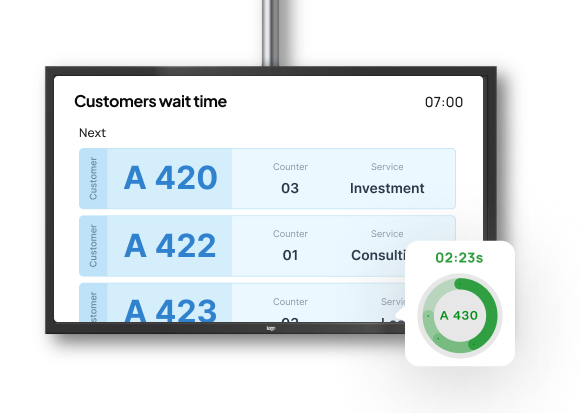Reviews
Reducing Wait Time Anxiety: How Queue Management Systems Address Customer Emotions?

Have you ever walked into a business on a busy day and noticed the tension among waiting customers? A parent in the waiting area juggles a restless child, nervously glancing at their watch. A professional keeps checking their phone, trying to calculate if they’ll make their next appointment.
Such scenarios are common and play out daily in healthcare, retail, and government offices.
Long or unclear wait times not only frustrate customers but also overwhelm staff and tarnish the business’s reputation.
The solution?
Implementing effective queue management strategies. By addressing both the operational and emotional aspects of waiting, queue management systems can transform how businesses manage customer flow and expectations.
Understanding Wait Time Anxiety and Its Impact on Customer Experience
Wait time anxiety isn’t just frustrating. It shapes how customers perceive your business. Disorganized queues and unclear updates make customers feel ignored, leading to eroded trust and, often, a decline in business.
In competitive industries, these moments can send them straight to your competitors. When customers feel undervalued or left in the dark about their turn, their frustration can ripple into poor reviews, lower satisfaction, and a growing preference for competitors who prioritize their time.
What Causes Wait Time Anxiety?
Not knowing how long they will have to wait increases stress for customers. Here are some of the key factors that contribute to wait time anxiety:
- Lack of Control: Customers often feel powerless when stuck in a queue, especially when it isn’t clear how the process works.
- Unfair Perceptions: When customers believe others are being served out of turn, it creates frustration even when prioritization is valid.
- Disorganization: A chaotic or inefficient queue makes the waiting experience even worse, increasing anxiety and dissatisfaction.
What Makes Queue Management Systems Effective in Reducing Anxiety?
No more endless ‘how much longer?’ Queue management systems show you exactly where you are in line and how much time you’ve got left, so the whole experience feels much more relaxed.
Consider a healthcare facility using a digital queue display. Patients can see their place in line and how long they’ll wait, making the experience feel fair and predictable. Virtual queue options are another game-changer. With remote check-ins and notifications when it’s their turn, customers can stop worrying about the clock and actually use their time how they want.
These systems create a win-win situation for everyone involved by providing clarity for customers and improving the workflow behind the scenes.

Psychological Benefits of Queue Management Systems
Eliminates the need for aimless waiting. With a queue management system like Q-nomy, customers can keep an eye on their place in line, know exactly how long they’ve got left, and even check in remotely from their phones. Less uncertainty and more peace of mind are what it’s all about.
Small touches, like a countdown or clear next steps, create a sense of transparency and fairness. These subtle details are what turn a simple wait into a positive, well-managed experience. By implementing these effective queue management strategies, you can transform frustration into satisfaction and make customers feel valued.
Advanced Features in Modern Queue Management Systems
Today’s systems offer a range of advanced features that go beyond basic queue management:
- Real-Time Analytics: Provides insights into customer flow, helping businesses predict and manage peak times.
- Mobile Integration: Customers can join queues or receive updates via apps or text messages, reducing the need for physical presence.
- AI-Driven Optimization: Systems can prioritize based on urgency or customer preferences.
- Feedback Tools: Collect customer feedback directly through the system to identify areas for improvement.
- Virtual Queues: Customers can wait wherever they choose, enhancing convenience and reducing on-site congestion.
Think of this system as more than just a number tracker – it’s designed to improve the whole customer experience, from the moment they join the queue to when they’re done.
Choosing the Right Queue Management System for Your Business
Selecting the ideal system means figuring out what your business really needs and what will keep your customers happy and comfortable while they wait.
Key Factors to Consider:
- Type of Queue Needed: Does your business require physical queues, virtual queues, or a combination?
- Customization: Look for systems that can match your branding and customer flow.
- Scalability: Ensure the solution can grow with your business.
- Ease of use: Both staff and customers should find the system intuitive.
- Integration: The system should connect seamlessly with existing tools or processes.
By addressing these factors, you can invest in a solution that enhances efficiency and customer satisfaction.
Conclusion
The goal of reducing wait time anxiety goes beyond shaving minutes off the clock; it’s making customers feel calm and in control during the wait. Modern queue solutions like Q-nomy provide clarity, structure, and personalization, ensuring customers feel valued and informed.
Have you implemented queue solutions in your business? Share your thoughts in the comments.

-

 Legal6 days ago
Legal6 days agoMichigan man JD Vance sentenced to 2 years for threatening Trump and JD Vance
-

 Politics1 week ago
Politics1 week agoU.S. to designate Maduro-linked Cartel de los Soles as terrorist organization
-

 Health7 days ago
Health7 days agoCambodia reports fatal H5N1 bird flu case in 22-year-old man
-

 World4 days ago
World4 days agoHurricane Melissa registered 252 mph wind gust, breaking global record
-

 Legal4 days ago
Legal4 days agoWoman in critical condition after being set on fire on Chicago train
-

 Politics7 days ago
Politics7 days agoEpstein survivors release PSA calling on Congress to release all files
-

 Legal4 days ago
Legal4 days ago1 dead, 2 injured in shooting at Dallas Walmart parking lot
-

 Legal3 days ago
Legal3 days agoSuspect in San Diego stabbing shot by authorities after fleeing into Mexico




